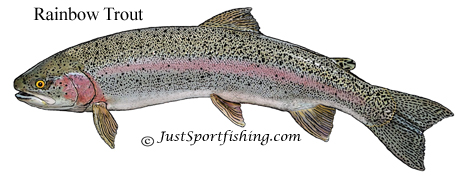|
Home Game Fish Fishing Knots Tackle Tips Videos Pictures Tips Rods & Reels Boats Cook your Catch Articles About Contact |
|
Donate to JustSportfishing.com and help to build the largest fishing information site on the web. Even a dollar or two will keep us building this free site.
|
Rainbow
Trout World
Record
~ 42 Lbs. 2 oz. Caught at Bell Island, AK on June 22, 1970 by angler
David Robert White Scientific
name
~ Oncorhynchus Mykiss Other
names
~ Bow, Redsides, Steelhead, Red-band Trout, Rainbow, Silver Trout,
Steelhead, Kamloops Identification ~ Rainbow Trout have an elongate, laterally compressed body. A rounded snout, which becomes extended and the lower jaw turns up in spawning males. The back, upper sides and the top of the head are steel blue, blue-green, yellow-green to almost brown. The sides of the Rainbow Trout are silvery, white or pale yellow-green to gray, and marked with a pink blush to red band and many small black spots. The underside is silvery, white or gray to yellowish. The dorsal and caudal fins have radiating rows of black spots, while the remaining fins are buff with few spots.
Size
~ Anglers that fish stream dwelling Rainbow Trout will encounter Rainbow
averaging a pound or less and up to 12 inches. Catches of
Rainbow that inhabit larger rivers and lakes can average from 2
to 4 pounds. When Rainbow Trout inhabit very large lakes and an abundant
supply of food is available they can reach large sizes but it is rare to
encounter a fish over 10 pounds. Habitat
~ The Rainbow Trout is a cold-water fish species. Temperature tolerance
of Rainbow Trout is from 32 F to over 70 F, their ideal temperature
range is between 55 and 60 F. The habitat of stream-dwelling rainbow
trout is usually small to moderately large, shallow rivers with moderate
flow and gravel bottoms, of the pool-riffle type. The lake-resident
trout are usually found in moderately deep, cool lakes with adequate
shallows and vegetation for good food production. For a lake population
to be self-sustaining, there must be a gravelly river to which the
adults can migrate during the spawning season. The Rainbow Trout native
range was the eastern Pacific Ocean and the freshwater west of the Rocky
Mountains, from northwest Mexico to Alaska, but today the Rainbow Trout
has been widely introduced to many countries around the world. Feeding
Habits
~ The Rainbow Trout generally feed close to the bottom of its habitat.
Adults feed on aquatic and terrestrial insects, crustaceans, fish eggs,
leeches minnows and other small fishes.
|


